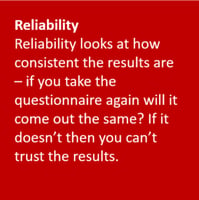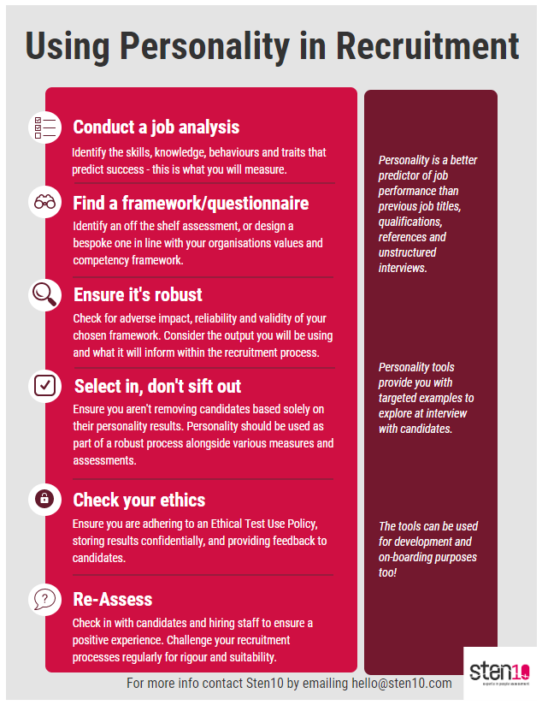As experts in assessment, we at Sten10 encounter a wide variety of personality frameworks and psychometrics. A key aspect of using any tool is using them properly: a poorly used psychometric is worse than no psychometric at all.
In this post we will explore the place of personality frameworks, assessments, tools and questionnaires within the recruitment process. We will provide guidance around how to use them ethically, and how to ensure that you are getting the most out of your chosen framework to hire the right staff for your organisation.
First, let’s talk about what they bring. Why use personality assessments in the first place?
They are good predictors of job performance. Particularly behavioural and trait-based tools which are reliable ways of assessing how people are likely to perform in the role. A well-known meta-analysis by Robertson and Smith (2001) places personality frameworks as moderately predictive of performance: a good deal more so than past work experience, references and unstructured interviews.
Personality questionnaires provide you with another metric on which to compare candidates. No longer do you have to judge them simply on their education, experience or previous roles. You can start to explore how candidates may fit in with the company’s culture, how they may assimilate into the team, and how they will prefer to work on a daily basis.
They help inform the interview process. Having someone’s results on a personality questionnaire enables you to identify candidate specific (or role specific) areas to probe at interview. These can tie directly in with your competency-based interview questions and provide a structure through which you can explore real examples of behaviours which are key to the role.
They also enable you to minimise legal risks regarding your recruitment process. Well-designed frameworks will ensure that questions aren’t discriminatory, that tools are measuring what they claim to, and that results are stable over time. Incorporating a tool which is fair and bias free within your recruitment process can minimise any potential legal ramifications later down the line.
And finally, they enable an outcome where both the candidate and the organisation are happier. With more targeted exploration of competencies and behaviours we can determine if individuals are the right fit for the role, whilst allowing opportunities for individuals to explore if the role is the right fit for them. Not to mention the developmental insights that can come out of using personality frameworks.
Now that you have decided to use a personality framework in your assessment process, here are some further considerations to fully explore.
1. Perform a thorough job analysis. Explore the role inside and out and identify the behaviours, competencies, skills or knowledge required to succeed in the role.2. Choose the right assessment for the role keeping the following in consideration:
-
- How does it measure the criteria determined from the job analysis? You can either find an off the shelf tool that closely maps onto your chosen criteria or design a bespoke assessment to align the areas being measured with your organisation’s competency or values frameworks.

- How does it measure the criteria determined from the job analysis? You can either find an off the shelf tool that closely maps onto your chosen criteria or design a bespoke assessment to align the areas being measured with your organisation’s competency or values frameworks.
-
- Is the assessment reliable and valid? Key psychometric properties that should be considered.
- Is the framework fair to all candidates? Is the language accessible to people of different backgrounds? Are there measures in place for candidates who many need additional support? Has it been reviewed to ensure there is no adverse impact?
- How much will it cost per use? Off the shelf assessments will charge per candidate they are administered to. If you are putting a large amount of people through your recruitment process evaluate if it is more cost effective to design a bespoke assessment. Once you have the framework designed for your organisation you can use it indefinitely with no usage fee per candidate.
- What qualifications are required to be able to use the assessment? Most off the shelf frameworks will require some qualifications to use them, some more rigorous than others.
3. Identify where in the process you would like to embed the personality assessment. Do you want to use it to inform the interview process and questions? Do you want to use it to form an induction plan for the new hires?
4. Decide what other tools will be used alongside the personality framework. Personality should be included as part of a thorough assessment process, never in isolation. A robust and ethical selection process includes multiple measures and assessments.
5. Ensure that you gain the individuals’ informed consent to use their data. Be clear about the purposes of using the tool and how and in what contexts the results will be used.
6. Ensure you have a system for providing feedback to candidates. All candidates are entitled to receive their results in the form of feedback if they want it, as it is their personal information.
7. Be careful to store the results securely and appropriately (complying with GDPR) with no-one who is unqualified being able to access the results.
8. Adhere to an Ethical Test Use Policy. If your organisation doesn’t have its own policy, you can check out the BPS Guidelines to keep things all above board.

Elephants in the room! It’s time to identify some common criticisms or concerns you might encounter when using personality frameworks.

"Aren’t people just going to answer to give a positive impression?" This is a common criticism of self-report measures, however there are several ways we mitigate this in the construction of personality questionnaires. 1. Use social desirability scales. Ask several questions that people will only endorse if they are trying to make a good impression, allowing you to take the results with a pinch of salt when interpreting them. 2. Give candidates feedback on their results to check the accuracy of the outcomes. 3. Use or design a forced-choice format questionnaire or a rank-ordering questionnaire. These force candidates to choose between equally positive options, giving a clearer glimpse at their natural preferences.

"The results screened out potentially good candidates!" As mentioned earlier, personality frameworks should never be the sole basis on which you eliminate potential candidates, and they shouldn’t be used in isolation. Personality tools provide a valuable set of data to be considered within a wider selection framework – they should always be used alongside other measures and assessments.

"But using them costs money!" Yes, doing things properly takes more time, and as a result more money. However, the benefit is hiring staff who are more suited to the role, hiring staff who want the role, and keeping retention and engagement levels higher from their first day with the company. In the end this will have significant impact on recruitment costs in the long term.
Final Thoughts
Having previously worked for a famous test publisher training people in the use of personality frameworks I would often get asked “which one do you think is the best?” A great question, however, my answer was never a simple as they wanted it to be: “it depends!”
Not especially helpful, but entirely true. It really does depend on what you want to get from the framework. Personality is such a vast concept, there is no single model that encompasses all of it, and it’s doubtful there ever will be one. Being an ethical test user is about identifying the right tool for the job at hand and then using it appropriately. It is not about finding the ‘one test’ that will fix every assessment problem you need to tackle.
We hope the considerations laid out here have provided you with some clear guidelines if you have not previously worked with personality assessments, or if you want to improve the rigour of your assessment process. If you have any questions about utilising personality frameworks within recruitment or would like to explore the possibility of designing a bespoke tool please get in touch by emailing hello@sten10.com.
References:
Robertson, I., and Smith, M. (2001). Personnel Selection. Journal of Occupational and Organizational Psychology, 74, 441-472.
At Sten10, we’ve created a checklist that outlines the challenges and tips for success when making the move to virtual assessment centres. To read the full checklist, click the link below




